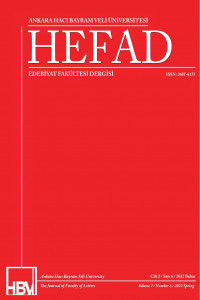Ahmed Burhaneddin’in Cumhûriyet Mefkûresi
Cumhuriyet Dönemi, Türk milletinin ölüm kalım mücadelesi verdiği bir sürecin sonucunda hem kendi hem de dünya milletleri nezdinde esarete boyun eğmeyeceğini, her türlü zorluğun üstesinden gelebileceğini ispatladığı bir dönüm noktasıdır. Türk milletinin, Kurtuluş Mücadelesini kazanması ve Cumhuriyet yönetimine geçilmesi neticesinde yeni devletin bekasının sağlanması için halkı da topyekûn içine alan birtakım yenilikler yapılır. Bu yeniliklerin ve Cumhuriyet yönetiminin benimsetilmesi amacıyla aydınlar, yazarlar, bilim insanları eserlerinde Cumhuriyet vurgusunu ön plana çıkarırlar. Özellikle 1923-1938 yılları arasında yazılan eserlerde Cumhuriyet neslinin nasıl olması gerektiğine ilişkin rol model örnekler sunulur ve ideal bir gençlik tipolojisi oluşturma çabası içine girilir. Bu bağlamda kaleme alınan eserlerden biri de Ahmed Burhaneddin’in Cumhûriyet Mefkûresi adlı eseridir. Ahmed Burhaneddin’in 1926 yılında yazdığı ve yer yer nutukvari bir üslup kullandığı Cumhûriyet Mefkûresi adlı bu eseri, Darülfünun öğrencileri nezdinde ideal Cumhuriyet gençliğinin nasıl olması gerektiğine dair yazılardan oluşmaktadır. Bu yazılar, Dârü’l-fünûn Gençliği, Hukûk Gençliği ve Türk Kadını Hâkim Olabilir mi? alt başlıklarını içermektedir. Ahmed Burhaneddin, eserinin sonuna Cumhuriyet Halk Fırkası’na güzellemelerde bulunduğu Gâzî’nin Fırkası’na başlıklı bir de şiir eklemiştir. Ahmed Burhaneddin, Türk milletinin zorlu süren savaşların ardından esarete boyun eğmeyerek yeniden doğuşunu simgeleyen Cumhuriyet idaresinin en kuvvetli kaynağı olarak millî bilinç ve irfanı görür. Millî bilinç, ulusun bekası, devletin devamlılığı gibi gelecek inşasına dair vurgular, Cumhuriyet’in ilanından sonra devletin de resmi ideolojisi olarak ön plana çıkar. Bu bağlamda resmi ideolojiyi, Cumhuriyet’in değerlerini benimsetmek ve ideal gençlik tasavvurunu yaygınlaştırmak amacı taşıyan Ahmed Burhaneddin, millî bilinç inşası için özellikle Darülfünun öğrencilerine seslenir.
Anahtar Kelimeler:
Ahmed Burhaneddin, Cumhuriyet Mefkûresi, ideal gençlik, Darülfünun, hâkim.
Ahmed Burhaneddin's Cumhûriyet Mefkûresi
The Republican Era is a turning point in which the Turkish nation proved, as a result of a process whereby it struggled for life and death, that it would not bow down to captivity and that it could overcome all kinds of difficulties. In order to ensure the survival of the new state as a result of the Turkish nation's victory in the Independence Struggle and the transition to the Republican administration, some innovations are made that appeal to the people as a whole. To make the people adopt these innovations and the Republican administration, intellectuals, writers and scientists emphasize the Republic in their works. Especially in the works written between 1923 and 1938, role model examples are offered about how the Republican generation should be and efforts and attempts are made to create an ideal youth typology. One of the works written in this context is Ahmed Burhaneddin's work called Cumhûriyet Mefkûresi. This work of Ahmed Burhaneddin, titled Cumhûriyet Mefkûresi, which he wrote in 1926 by using a speechlike style from time to time, consists of articles on how the ideal republican youth should be with reference to the students of Darülfünun. These articles contain the subheadings of Dârü'l-fünûn Youth, Youth in Law and Can Turkish Women Be a Judge? Ahmed Burhaneddin added a poem titled To Gâzî's Party at the end of his work, in which he heaps praise on the Republican People's Party. Ahmed Burhaneddin sees national consciousness and wisdom as the strongest source of the Republican administration, which symbolizes the rebirth of the Turkish nation by not surrendering to captivity after hard wars. Emphasis on the construction of future, such as national consciousness, survival of the nation, and continuity of the state, came to the fore as the official ideology of the state after the proclamation of the Republic. In this context, Ahmed Burhaneddin, who aims to have the official ideology and the values of the Republic adopted and to spread the ideal youth vision, specifically addresses the students of Darülfünun for the construction of national consciousness. In this article, the ideal youth understanding in Ahmed Burhaneddin's work titled Cumhûriyet Mefkuresi will be explained.
Keywords:
Ahmed Burhaneddin, Ideal of the Republic, Ideal Youth, Darülfünun, Judge,
___
- Ahmed Burhaneddin (1926), Cumhuriyet Mefkûresi -Dârülfünûn Gençliği-, İstanbul: Amedi Matbaası.
- Batagur, A. Erdem (2012), Ord. Prof. Dr. A. Burhaneddin Toker (1890-1951) ve Usûl-i Cerrahiyye ve Ameliyât ile Gençleştirme Risalesi (1922): XX. Yüzyılın Başında Gençleştirme
- Çılgınlığı, Yeni Tıp Tarihi Araştırmaları / N History Med Stud, 2012;18, s.29-42
- Dinç, M. Sc. Gülten (1993) Arap Harfleri ile Türkçe Basılmış Tıbbî- Süreli Yayınlar Üzerine Bir İnceleme II, Tıp Tarihi Araştırmaları, 5, 96- 131.
- Göksoy, Ertuğrul (2001) Ord. Prof. Burhaneddin Toker – Ölümünün 50. Yılında Yaşamı ve Eserleri, Yeni Tıp Tarihi Araştırmaları, s. 387-431
- ISSN: 2687-6175
- Yayın Aralığı: Yılda 2 Sayı
- Başlangıç: 2019
- Yayıncı: Ankara Hacı Bayram Veli Üniversitesi
Sayıdaki Diğer Makaleler
Ahmed Burhaneddin’in Cumhûriyet Mefkûresi
Cumhuriyet Döneminde Türk Lehçeleri Üzerindeki Kaynak Çalışmalarına Genel Bakış
Türk Halk Bilgisi Derneği ve Çalışmaları
Erken Cumhuriyet Döneminde Claude Farrère’in Gözünden Türkler
Nesrin TEKİN ÇETİN, Fatma Büşra SÜVERDEM, Gökçe Mine OLGUN, Dilara PINARBAŞI, Mehmet KÖLE
Osmanlı İmparatorluğu'nun ve Türkiye Cumhuriyeti'nin Arkeolojiye Bakış Açıları
Coğrafya Öğretmenlerinin Coğrafi Sorgulama Çalışmaları ve Yaşadıkları Sorunlar
Cumhuriyet Düşüncesinin Felsefi Temelleri Hakkında Bir İnceleme
